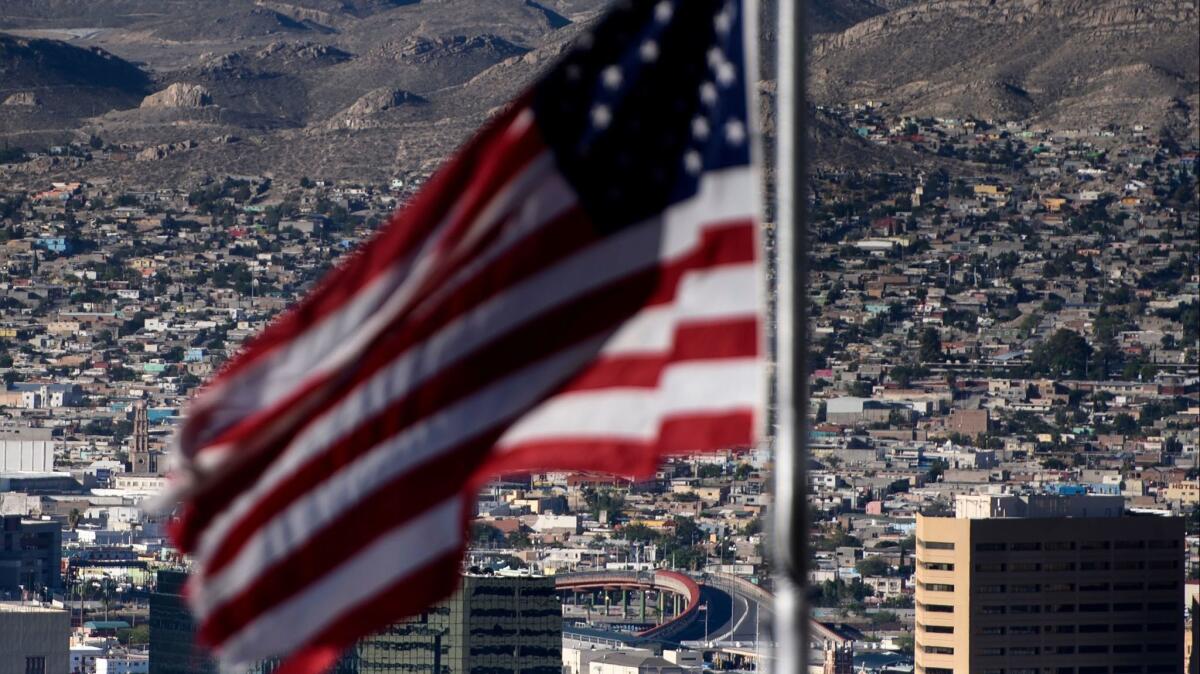Editorial: Trumpâs Mexican tariff ploy is the art of dealing in bad faith

Frustrated by the surge in asylum-seeking families on the southern border, President Trump has threatened to start another trade war â this time with Mexico, the United Statesâ biggest trading partner at the moment. The problems at the border are real, but the presidentâs response is a tantrum. Mexico deserves better, and so do we.
The number of arrests at the border has increased rapidly in recent months, jumping from about 700 per day in May 2017 to 4,500 per day in the first three weeks of May 2019, according to the Trump administration. And while the total remains below its level in the early 2000s, far more of those detained are Central American families seeking asylum, which the system is poorly equipped to handle, instead of single males seeking work, who can be deported quickly.
Trump pointed the finger of blame Thursday at Mexico, saying its âpassive cooperationâ enables migrants to flow northward from Central America into the United States. He gave the country less than two weeks to alleviate the âillegal migration crisisâ or else face tariffs on all its exports to the United States, starting at 5% and escalating to 25% by Oct. 1.
But the president is demanding the impossible â stopping a human tide of people desperate to escape dangerous and impoverished areas â while establishing no criteria for success. As it is, Mexico has sent home more than 600,000 Central Americans since 2014, and diverted others by offering humanitarian visas and work permits if they remain in Mexico rather than continuing to the U.S. border. It also recently announced plans to bolster security at its border with Guatemala and to try to throttle passage of migrants by establishing a security cordon across the 125-mile-wide Isthmus of Tehuantepec, Mexicoâs narrowest point.
The president is demanding the impossible while establishing no criteria for success.
The Trump administration is willfully misreading what steps Mexico has taken to try to address a problem from which it suffers as much as the U.S. And itâs beyond rational comprehension to hold Mexico responsible for stopping what is clearly a regional migration problem while imposing the punishment on American consumers and businesses. Because thatâs who will pay the tariffs on imported Mexican-made machinery, produce, medical instruments, vehicles and other products â us.
If it were possible to âeasily halt the illegal flow of migrants,â as Trump claims Mexico can do simply by enforcing its âstrong immigration laws,â then the U.S. should be able to put a cold stop to migration through its southern border. Our own failures on that front demonstrate that Trumpâs new approach is just more bluster and folly.
Trumpâs threat was announced just as lawmakers in the U.S., Mexico and Canada were starting to consider the update to NAFTA that Trump insisted on negotiating â and which the new tariffs would mock. But then, this president hasnât met an agreement he wouldnât abrogate, even if he was the one who negotiated it. Call it the art of dealing in bad faith.
Which only raises the question, why would any world leader strike a deal with Donald Trump? And why would Congress?
The president also blamed congressional Democrats for ârefusing to help in any way, shape or form.â But thatâs misleading â lawmakers from both parties are still negotiating with the White House over the details of billions of dollars in emergency funding to deal with the influx of migrant families.
Enter the Fray: First takes on the news of the minute Âť
As with so many things Trump does, his latest gambit may be just a threat aimed at bullying some quick concessions out of Mexico, which announced plans to send a delegation to Washington to talk. But itâs an enormous gamble, given how much of the U.S. economy would be affected. Not only do many U.S. manufacturersâ supply chains run through Mexico â especially in the auto industry â but Mexico is the top importer of U.S. goods. Those sales could slump if Mexico retaliates with tariffs of its own. Not surprisingly, stock markets tanked Friday morning in response to the news.
The administration insists the tariffs are legal under the 1977 International Emergency Economic Powers Act, which ordinarily gets invoked to penalize or control the flow of sensitive technologies to hostile nations. The problems at the border may be severe, but they pose a humanitarian challenge for the region, not a national security threat to the United States.
Count the Mexico tariffs, then, as just the latest step by Trump to stretch the limits of presidential authority in order to push his agenda unilaterally. One of the presidentâs congressional allies, Sen. Charles Grassley (R-Iowa), called Trumpâs move âa misuse of presidential tariff authority and counter to congressional intent.â But Grassley and his colleagues looked the other way as Trump misused the same authority to impose global tariffs on steel and aluminum imports on a national security pretext, and to threaten to do the same on auto imports. Itâs past time for them to rein Trump in.
Follow the Opinion section on Twitter @latimesopinionand Facebook
More to Read
A cure for the common opinion
Get thought-provoking perspectives with our weekly newsletter.
You may occasionally receive promotional content from the Los Angeles Times.










